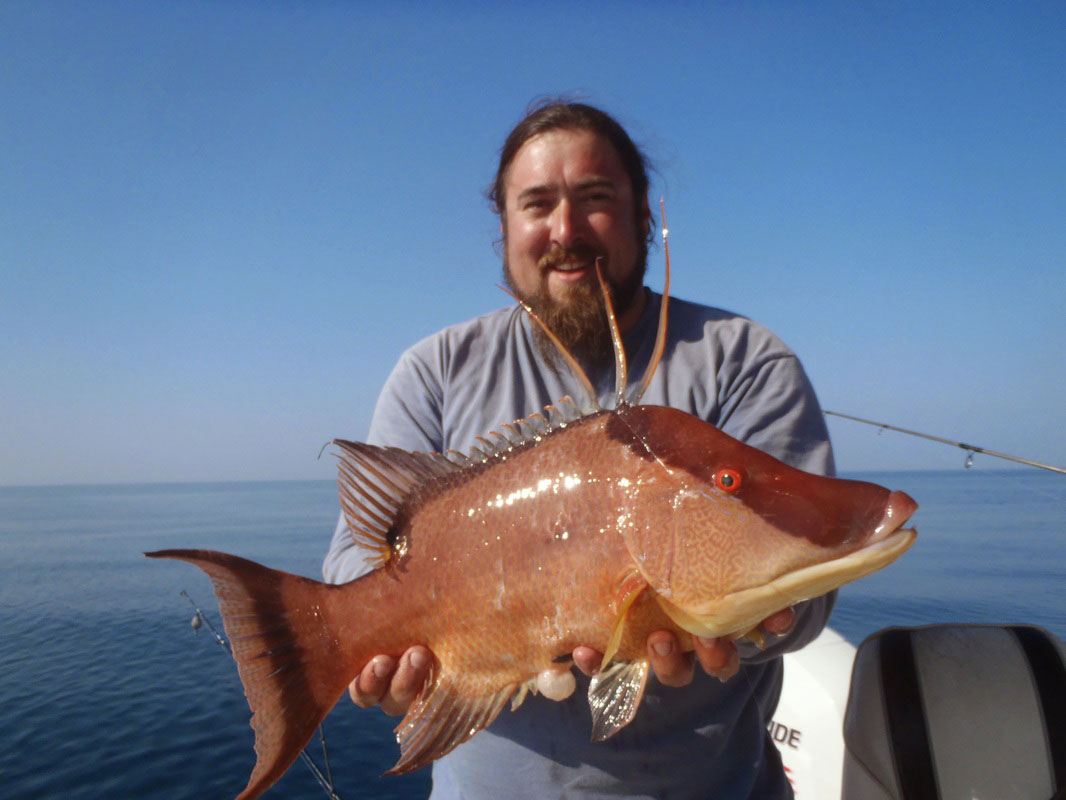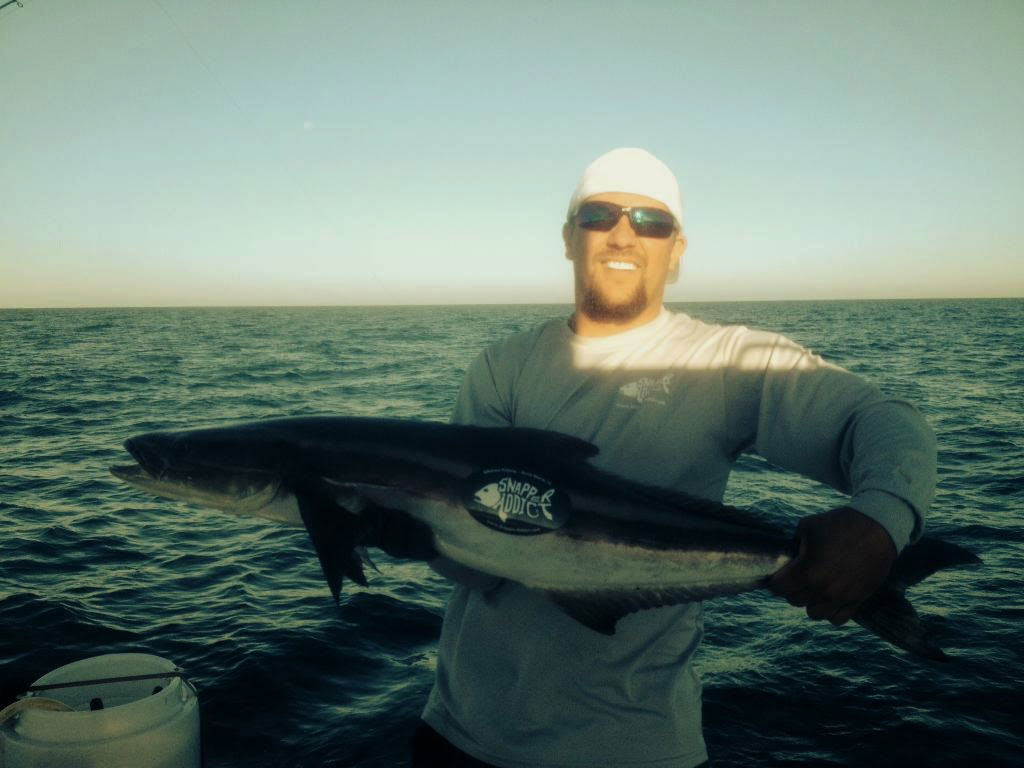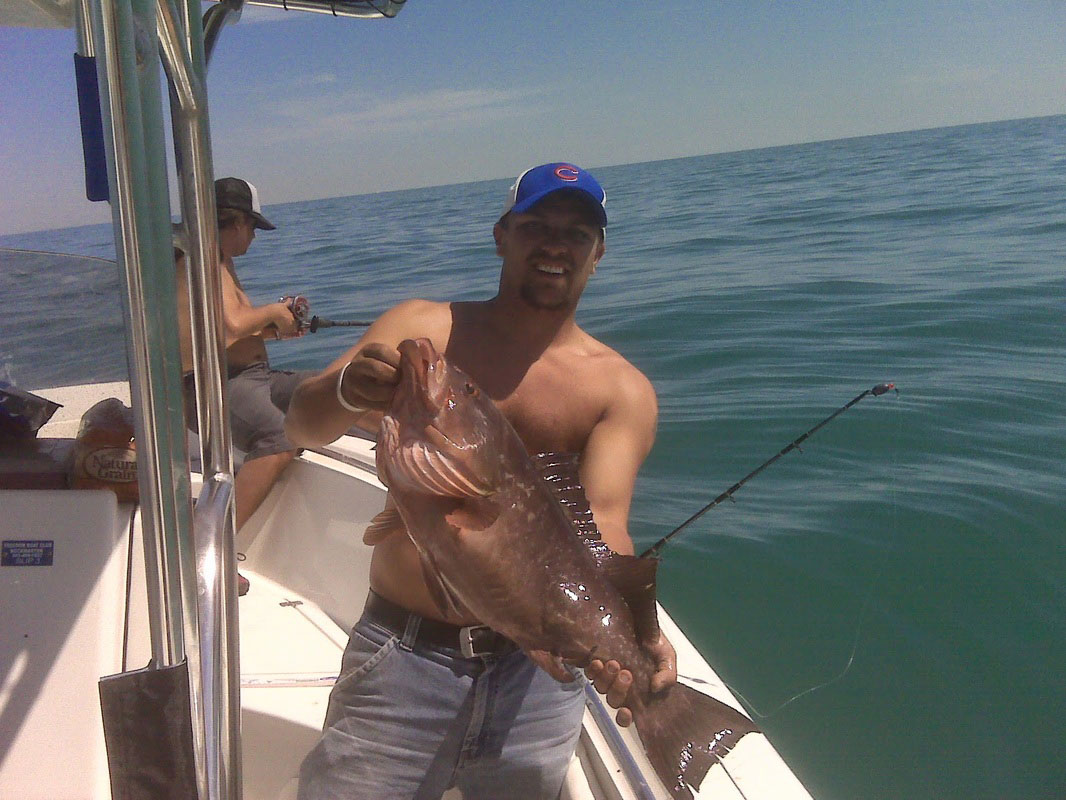Fish Species

Hogfish
Lachnolaimus maximus, the hogfish, is a species of wrasse native to the western Atlantic Ocean, with a range from Nova Scotia, Canada to northern South America, including the Gulf of Mexico. This species occurs around reefs, especially preferring areas with plentiful gorgonians. This species is currently the only known member of its genus.

Gray/Mangrove Snapper
Appearance: Dark brown or gray with reddish or orange spots in rows along the sides.
- A dark horizontal band from snout through eye is present in young only
- Two conspicuous canine teeth are present at front of upper jaw
- Ddorsal fins have dark or reddish borders
- No dark spot is present on side underneath dorsal fin
Habitat: Juvenile gray snapper are found inshore in tidal creeks, mangroves, and grass beds. Adults are generally found nearshore or offshore on coral or rocky reefs.
Behavior: Spawning occurs June through August. Gray snapper feed on crustaceans and small fish.State Record:
Fishing Tips and Facts: Gray snapper caught offshore are common 8 to 10 pounds. Gray snapper are similar in appearance to the cubera snapper, L. cyanopterus.

Cobia
Rachycentron canadum
Appearance:Long, slim fish with a broad depressed head
- The lower jaw protrudes past the upper jaw
- Dark lateral stripe extends through the eye to the tail
- First dorsal fin has 7 to 9 free spines
- When young, has conspicuous alternating black and white horizontal stripes
Habitat: Cobia are found in nearshore and inshore waters with inlets and bays. Cobia are frequently found around buoys, pilings and wrecks in these areas.
Behavior:They spawn in spring and early summer.
State Record: 130 lb 1 oz, caught near Destin.
Fishing Tips and Facts:Live crabs and small fish are good baits for cobia. Keep bait near the surface or, if cobia are deeper, add just enough weight to get the bait down and still retain its movement. Medium to heavy tackle is required to land these fish which average 30 pounds. Large specimens in the 50-80 pound class are frequently caught and cherished by the lucky angler who outmatches these powerful fish. Cobia are excellent table fare.

Gag Grouper
Mycteroperca microlepis
Appearance:Brownish gray in color with dark, worm-like side markings
- Fins dark, with anal and caudal having a white margin
- Lack of brassy spots as found on black grouper
- Slightly concave tail
- Noticable spur located on the preopercle
Habitat: Adults inhabit rocky bottoms, reefs and drop-off walls in water over 60 feet deep; young occur inshore in waters around seagrass beds, mangrove forests and hard-bottom communities.
Behavior: Grouper are born as females but can later become male. Gag and red grouper are the most widely distributed of the Florida groupers. Goliath and Nassau grouper are protected from harvest in Florida waters. Grouper spawn between January and May with some of the more tropical species spawning year-round.
State Record: 80 lb 6 oz, caught near Destin
Fishing Tips and Facts:Grouper fishing from a boat typically involves baits fished near the bottom, with heavy tackle and heavier to bring grouper to the surface. Live fish or dead cut or whole bait are used. Grouper are very tasty meals.

Bonito
The little tunny (Euthynnus alletteratus) is the most common tuna in the Atlantic Ocean. It is found in warm temperate and tropical waters of the Atlantic and the Mediterranean; in the western Atlantic, it ranges from Brazil to the New England states. It is found regularly in offshore and inshore waters, and is classified as a highly migratory species by UNCLOS. Occurring in large schools and weighing up to 36 lb, it is the smallest member of the tuna Scombridae family, and is one of the finest small game-fish in the Atlantic.
Commonly called false albacore or little tuna, it resembles the Atlantic bonito, skipjack tuna, and species of mackerel. The little tunny feeds primarily on pelagic fish. It is best identified by the dark spots appearing between its pectoral and ventral fins and “worm-like” markings on its back. Commercially, the fish is used as bait for sharks and marlin due to its high oil content and hook retention. It is considered by many to be a trash fish because of its limited nutritional value; ciguatera poisoning related to its consumption has even been reported. However, the little tunny is commercially important in many locations, including the West Indies. It is marketed fresh, dried, canned, smoked, and frozen. It is sought-after as a sport fish due to its line-stripping 64 km/h (40 mph) runs and hard fighting ability when hooked. By trolling with lures near reefs, it can be caught on hook and line.

Sheepshead
Archosargus probatocephalus
Appearance:Basic silvery color with 5 or 6 distinct vertical black bars on the sides; bars are not always the same on both sides
- Prominent teeth, including incisors, molars and rounded grinders
- No barbels on the lower jaw
- Strong and sharp spines on the dorsal and anal fins
Habitat: Sheepshead are an inshore species and are commonly found around oyster bars, seawalls and in tidal creeks. They move nearshore during late winter and early spring for spawning.
Behavior: Sheepshead are fractional spawners (they only lay a portion of their eggs at a time) in inshore waters, typically in March and April. They are omnivorous feeding mostly on crustaceans and small fish.
State Record: 15 lb 2 oz, caught near Homosassa
Fishing Tips and Facts:Use live shrimp, sand fleas or fiddler crabs on a small hook fished on the bottom. When cleaning, beware of the sharp gill covers.

Barracuda
The barracuda is a ray-finned fish known for its large size and fearsome appearance. Its body is long, fairly compressed, and covered with small, smooth scales. Some species can reach up to 2.1 m (6.9 ft) in length and 30 cm (12 in) in width. The barracuda is a saltwater fish of the genus Sphyraena, the only genus in the family Sphyraenidae, and is found in tropical and subtropical oceans worldwide ranging from the Eastern border of the Atlantic Ocean to the Red Sea and Caribbean Sea. They are found near the top of the water and near coral reefs and sea grasses.

Red Grouper
Epinephelus morio
Appearance: Color brownish red
- Lining of mouth scarlet-orange
- Blotches on sides in unorganized pattern
- Second spine of dorsal fin longer than others
- Pectoral fins longer than pelvic fins; squared off tail
- Margin of soft dorsal black with white at midfin
- Black dots around the eyes
Habitat: Red grouper are a bottom dwelling fish associated with hard bottoms. Juveniles are found offshore along with adults greater than 6 years old. Fish from 1 to 6 years occupy nearshore reefs.
Behavior: This fish spawns in April and May. Red grouper prefer water temperatures between 66 and 77 degrees F. Like many other grouper, red grouper undergo a sex reversal; young individual females becoming males as they age. Red grouper have a lifespan of at least 25 years. They feeds on squid, crustaceans, and fish.
State Record: 42 lb 4 oz, caught near St. Augustine Inlet